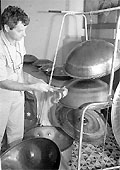STEELPAN SCHOLARS STUN LOCAL TUNERS

FELIX ROHNER of Panart in Switzerland explains the working of
a new line of pan “Ping Pang Peng” at the first international conference
on the Science and Technology of the Steelpan at Crowne Plaza yesterday.
Photo: STEVE MC PHIE
By Terry Joseph
DAY ONE of the First International Conference on the Science and Technology of the Steelpan (ICSTS), left veteran tuners in awe at the body of research work presented by a number of engineering scholars.
Nor was the bewilderment of the pan-tuners limited to the complexity of quadratic equations and principles of physics used to explain what was hitherto seen at street-level as little more than a jealously guarded indigenous art.
Some 100 scholars, tuners, students (from as young as 11 years old), plus a slew of foreigners, including Su Su Mu from Japan, Guyanese, Jamaican, European and North American registrants, remained glued to the podium and overhead projection screen from 9.30 a.m. to sundown, as presenters detailed their research findings.
There were those who felt that the language of the conference sailed over the heads of practitioners. Former Pan Trinbago public relations officer, Selwyn Tarradath, argued that the information would be of little use to locals, as the technology is unavailable here for continuing research initiatives outlined by the visiting scholars. Fasil Muddeen of the University of the West Indies (UWI), confessed that no anechoic chamber was accessible for his experiments in miking the tenor pan.
But for the most part, members of the audience agreed that the information disseminated was priceless and that the ICSTS was long overdue. They found out at first base that the words "steelpan" and steel drum" were not interchangeable. They also discovered that the positioning of a microphone to pick up pan sounds need not be a luck and chance exercise.
Those were the relatively easy lessons. The more intricate examples involved explanations of a conspiracy of forces, linear, quadratic and cubic, which affect the vibrations of notes and descriptions of pictures of holographic interferometery as support visuals for arguments relating to modal analysis.
Engineers were talking music to pannists and tuners, in a language sometimes steeped in trigonometry. "This may be complex at times, but it was just too historic to miss," is how cultural researcher John Cupid described the morning session. Fazal "Moosh" Mohammed said he was going back to his school, El Dorado Senior Comprehensive, to press for a closer alliance between the music teachers and the physics lab. "Clearly, this is what should have been taking place all the while and at least from the high school level," he opined.
The brunt of local research has been going on at UWI, thanks to the determination of Dr Andrew Achong, Dr Derek Gay and others attached to the engineering and natural sciences departments; many of whom pursue their experiments at personal expense.
Mounted by Dr Anthony Achong and professional colleagues at UWI and co-sponsored by the National Institute for Higher Education, Research, Science and Technology (Niherst) and Pan Trinbago, the ISCTS enters its second day today at the Crowne Plaza in Port of Spain.
Apart from Dr Achong, Dr Derek Gay, Muddeen and Dr Brian Copeland of UWI, yesterday’s list of presenters included Professor Thomas Rossing, Head of the Physics Department of Northern Illinois University, Uwe J. Hansen, Dept. of Physics, Indiana State University and Felix Rohner of Panart in Switzerland.
The conference addressed the theory and science of the steelpan, harmonically related parametric excitations on the notes, detuning and tonal structure, modal analysis and acoustical radiation in the morning session.
In the post-lunch period, it tackled finite element modeling of pan acoustics, holographic, computer, sand patterns and microphone scanning, modes of vibration, polar response, sound spectra of bass pans, the dynamical equivalent of the steel instrument and an electronic "score sheet" for pan.
The ICSTS continues today with discussions on the pan stick and its properties, new materials, pan specifications, the nitriding process (as an alternative to heating the drums), technology of a new raw form, the pang instruments, measuring surface stress, techniques of complex tuning, control of note behaviour, the engine room and a special narration of the life and work of an extraordinary pan pioneer, Bertie Marshall.
The cost of registration (which may be done for any chosen day) includes one copy of the conference proceedings, conference bag, lunches and tea/coffee.
UNKNOWN BAND TROUNCES TRINIS
END
Trinicenter home | Trini-News & Views